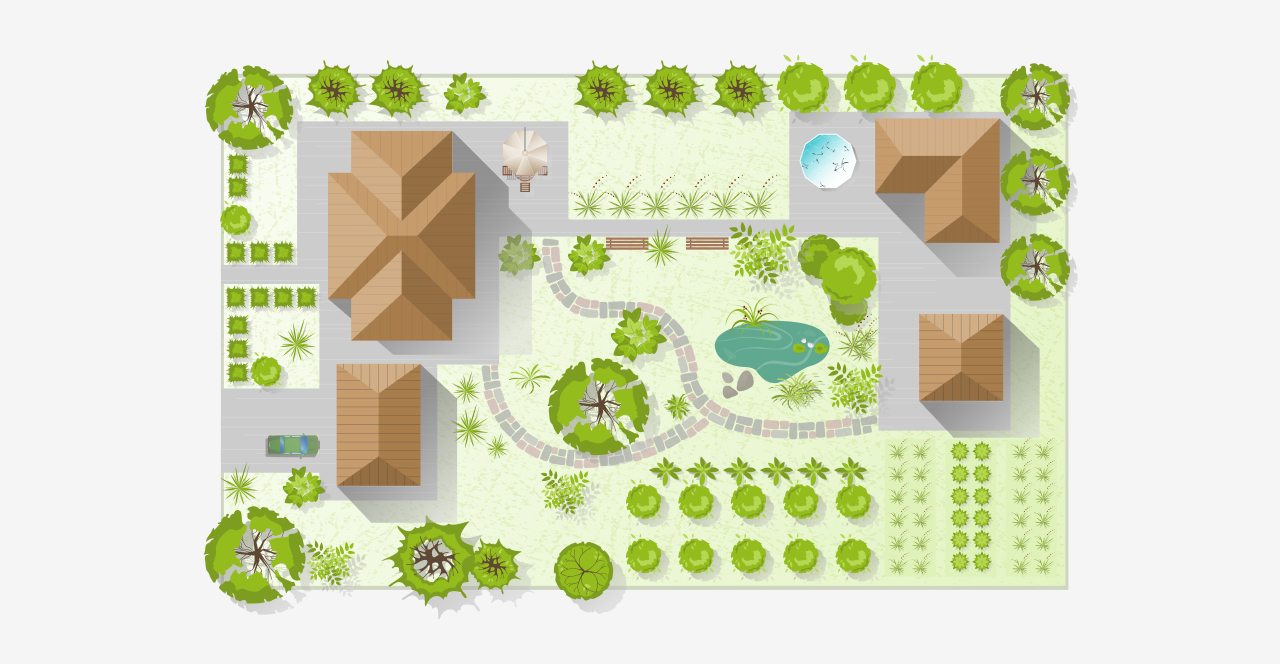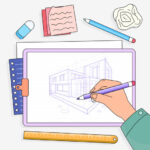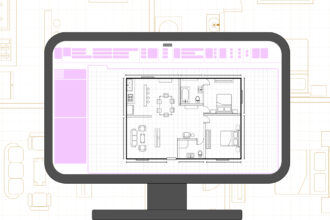Have you ever looked at an empty outdoor space and envisioned how it could be transformed into a vibrant environment? Landscaping is precisely that—the art of shaping spaces and infusing them with life, seamlessly connecting nature and design.
In 2025, new inspirations are emerging for those aiming to elevate ordinary spaces into immersive sensory experiences.
For professionals constantly seeking innovation to deliver projects with distinct character, this year brings compelling trends to explore.
In this article, Blocks® presents 9 exclusive trends designed to inspire your next landscaping projects.
Ready, landscape architects? Enjoy your reading! 🙂
What Is a Landscaping Project?
When discussing landscaping, many might envision only beautiful gardens or well-maintained flower beds. However, landscaping extends far beyond that.
A landscaping project is comparable to a work of art, where every element—plants, stones, lighting, colors, and textures—is thoughtfully integrated to achieve balance.
This process involves careful planning, thorough site analysis, and, importantly, a creative approach to transforming outdoor environments into spaces that invite relaxation and foster interaction with nature.
In essence, it’s not merely about enhancing aesthetics but about crafting an experience—whether in a private residential garden or a large urban park.
Why Is a Landscaping Project Important?

The value of a landscaping project transcends visual appeal. It reshapes environments not only in appearance but also in function.
Picture a space where every detail has been planned to provide comfort, well-being, and even promote sustainability.
Landscaping contributes to quality of life by bringing more greenery and freshness into everyday spaces, while also creating environments that invite social interaction, leisure, and connection with nature.
Consider waking up on a bright, refreshing morning with the desire to engage with nature. Instead of venturing out to a park or hiking trail, a well-designed landscape allows this connection from the comfort of one’s home.
Tailored to individual needs, each project becomes a reflection of personal lifestyle and environmental harmony.
Thus, landscaping is about bringing spaces to life—making them inviting, functional, and sustainable.
How to Create a Landscaping Project?
Designing a landscaping project involves several critical stages before reaching the final plan. Here’s an overview of the key steps:
- Detailed Site Analysis: The process begins with a comprehensive assessment of the available space, including soil conditions, sunlight exposure, climate patterns, and circulation flow.
- Plant and Material Selection: Based on the analysis, appropriate plant species, textures, and structural elements are selected—balancing functionality and visual appeal.
- Landscaping Design Plan: With insights from the site analysis and client preferences, a detailed design plan is developed, guiding the entire project execution.
While these represent the primary phases, project specifics may require customized planning approaches.
Landscaping Project: 9 Trends for 2025!
Now, let’s explore the top landscaping trends for 2025. Get ready because we’ve prepared some of the best tips for you to incorporate into your projects this year.
1. Native Plants Landscapes

First on our list is a native plants project, one of the most interesting trends in landscaping.
Native plants are naturally adapted to the region’s climate, soil, and conditions, meaning they require less maintenance.
They also promote biodiversity by attracting local birds, insects, and other animals, they enrich outdoor environments and support ecosystem preservation.
By choosing native species, you’re contributing to ecosystem preservation and creating a more authentic space in harmony with the surrounding environment.
2. Sustainable Landscaping Projects

Sustainability remains a core focus in landscape design.
Environmentally conscious decisions guide every aspect of sustainable landscaping projects—from selecting eco-friendly materials to implementing efficient systems for managing natural resources, such as water-saving irrigation solutions.
But sustainable design doesn’t stop there. These projects also incorporate strategies like organic waste composting, solar-powered lighting, and the use of drought-tolerant plants. Each choice contributes to reducing environmental impact while enhancing the resilience and longevity of the landscape.
3. Vertical Gardens and Green Roofs

As urban spaces grow denser and available land becomes scarcer vertical gardens and green roofs emerge as innovative solutions to integrate greenery into compact environments.
They’re ideal for adding greenery to small spaces, like buildings and urban areas.
Besides being visually stunning, these solutions help improve the microclimate by lowering temperatures and retaining moisture in the air.
Green roofs, for instance, act as natural thermal insulators, while vertical gardens bring nature to concrete settings.
4. Organic Edible Garden

Landscaping extends beyond aesthetics, incorporating organic edible gardens as a growing trend.
These spaces offer a practical and sustainable way to produce fresh herbs, vegetables, and fruits, directly contributing to healthier lifestyles.
Even in apartments well-designed edible gardens can thrive, fostering a closer relationship with food and the environment.
These functional landscapes combine beauty with purpose, supporting local food production while enhancing outdoor design.
5. Sensory Landscaping Design

Have you heard of sensory landscaping? This approach goes beyond visual appeal and creates spaces that engage all the senses.
For example, imagine strolling through a garden that not only captivates the eye but also offers varied textures beneath your feet, enticing aromas, and calming natural sounds.
Designed to provide a truly immersive sensory experience, this type of project is ideal for both residential gardens and public spaces.
Incorporating aromatic plants such as lavender and basil introduces a fragrant dimension, while thoughtfully placed stones create a distinctive tactile sensation as you walk.
6. Multifunctional Outdoor Spaces

As modern lifestyles become increasingly dynamic, multifunctional outdoor spaces have emerged as a key component in contemporary landscaping projects.
The objective is to design environments that seamlessly accommodate a variety of uses throughout the day—transitioning from vibrant social gatherings to tranquil moments of relaxation immersed in nature.
Pergolas, decks, and adaptable outdoor furniture serve as essential elements in these designs, blending practicality with aesthetic appeal.
Moreover, flexible layouts enable the space to transform effortlessly, whether hosting an al fresco dinner, enjoying a quiet reading session, or simply unwinding in a serene corner.
In these projects, every square foot is optimized, ensuring functionality and comfort without compromising on style.
7. Modern Design with a Natural Touch

Striking the right balance between modern aesthetics and natural elements remains one of the strongest trends in landscape architecture today.
In a world increasingly shaped by technology, bringing a touch of nature into contemporary spaces creates a contrast that enhances both visual and emotional appeal.
This approach combines materials such as concrete, glass, and metal with organic elements like wood, stone, and greenery, creating a seamless dialogue between the urban and the natural.
It’s an ideal solution for those seeking a sophisticated environment that retains the warmth, tranquility, and restorative qualities of nature—blending sleek modernity with timeless organic textures.
8. Landscaping with Creative Lighting

Lighting design plays a pivotal role in landscaping, with the power to completely transform the ambiance of outdoor spaces. When applied creatively, lighting extends far beyond functionality, shaping mood, enhancing focal points, and defining the overall character of the environment.
It’s not merely about illuminating features after dark—it’s about curating scenes and atmospheres that evolve throughout the day and night.
Techniques such as in-ground fixtures to outline pathways, directional spotlights to accentuate trees or architectural elements, and suspended lighting to introduce a sense of enchantment offer diverse possibilities for crafting unique experiences.
By incorporating strategic lighting design, outdoor spaces become versatile, inviting environments that can be enjoyed at any hour, while offering dynamic visual compositions that elevate the landscape’s aesthetic appeal.
9. Landscaping with Plenty of Wood

Closing out this list, is one of the most timeless elements in landscape architecture: wood.
Wood brings warmth and sophistication like few materials can, and it’s versatile for many applications.
Whether incorporated into decks, pergolas, or even outdoor furniture, wood introduces a natural and inviting character to any space.
Its integration with natural tones and vegetation fosters an atmosphere where rustic charm seamlessly blends with refined design.
Blocks Plugin: Streamline Your Landscaping Projects in Revit!
Planning your next landscaping project in Revit®? Let Blocks® simplify the process.
Our plugin empowers you to design your landscaping project with ease and precision. With just a few clicks, you can integrate detailed elements into your landscaping, architectural, or interior design projects.
The Blocks Plugin features a robust library of over 5,000 parametric families, designed to add the perfect finishing touch to your landscaping, architectural, or interior design projects.
Additionally, our dedicated team of BIM specialists continuously develops new content, ensuring your projects remain at the forefront of innovation.
Interested in learning more about the Blocks Plugin? Download it now for free and start enhancing your projects today!
Conclusion
Did you enjoy discovering the top landscaping project trends for 2025? Now, you’re filled with inspiration and ready to start your next designs with fresh ideas and valuable insights.
It’s clear that outdoor design—or landscape architecture—goes far beyond aesthetics.
Every detail, from material choices to plant selections, holds the power to transform spaces into vibrant, functional environments that foster a connection with nature.
Now it’s your turn to take these inspirations and create landscapes that embody harmony, modernity, and sustainability in every project.
Want access to more content like this? Be sure to follow the Blocks blog for the latest trends and insights!













